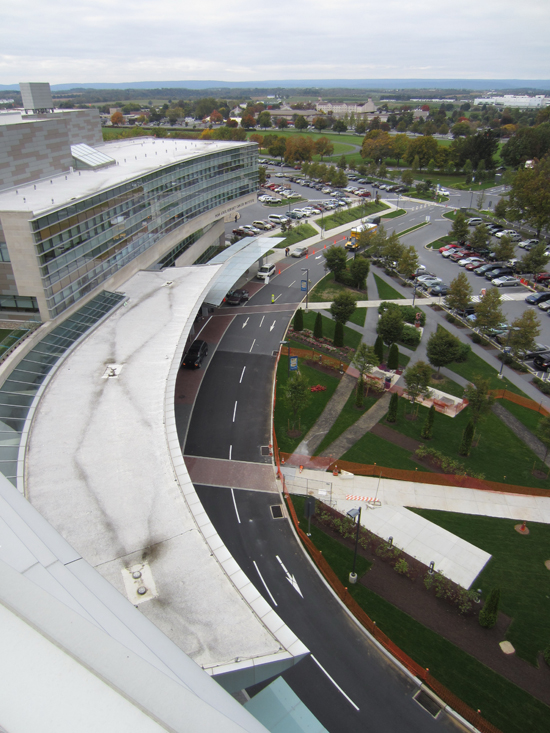
I recently read this article from Fast Co suggesting that roof coatings may not need to be white to be effective for “cool roofs.”
That got me thinking about the topic of “cool roofs” in general, which seems to be controversial. Various organizations have opinions. Which are correct? What are the myths and realities?
In the last decade, sustainability organizations (LEED in particular) originally drove the market towards increased use of “cool roofs.” LEED, Green Globes, and Roof Point standards all have points associated with using a “cool roof.” Various manufacturer organizations have their own recommendations on use of cool roofs. Building standard and code organizations (ASHRAE, IECC, IgCC) all include requirements or recommendations on use of cool roofs. In addition, government agencies (DOE) and local cities and towns may have their own recommendations (or requirements) on use of cool roofs.
Most of the standards and organizations appear to agree that using a cool roof is beneficial when used in a warmer climate (Climate Zones 1, 2, and 3). What should be done for projects in Zones 4, 5, 6, and 7?
Here are possible myths or realities:
Myth/Reality #1
It Never Makes Sense To Use A Cool Roof In A Climate With More Heating Degree Days Than Cooling Degree Days.
Building type/occupancy type, temperature/humidity parameters, HVAC system types, fuel types and sources, and many other factors influence the decision. With low-slope roofing, sun angle is low in winter and roofing may be covered with snow, all reducing any heat gain benefit. Energy-intensive buildings with a lower temperature “balance point” may still be in cooling mode for greater portions of a year. Also, the insulating effect of snow cover on a roof is enhanced by a highly reflective roof surface.
Myth/Reality #2
Effect On Building Energy Performance Is The Only Consideration When Deciding Whether To Use A Cool Roof.
There are other effects of using a cool roof that should be considered, such as Heat Island Effect, Global Warming Potential, Energy Grid Peak Load Impacts, Roofing Durability, and Impact on Insulation Effectiveness.
Myth/Reality #3
LEED and Other Sustainable Rating Systems Promote ‘Point Chasing’ For Pursuing A Cool Roof For All Projects.
Point chasing could be possible but only if the applicants choose to use cool roofing without weighing the benefits and disadvantages. None of the rating systems require a cool roof as a prerequisite. LEED and Green Globes don’t appear to recognize climate zones, but additional regional priority credits can apply to warmer or urban climates. In addition, LEED and Green Globes consider “cool roofs” to be a sustainable sites issue (the purpose of the credit is not building energy performance, which is evaluated as a separate credit). Roof Point does recognize climate zones, but allows high albedo or medium albedo for Zone 4; high, medium, or low albedo for Zones 5 and 6; medium and low albedo for Zones 7 and 8.
Myth/Reality #4
Cool Roofs Should Not Be Used In Climates That Get A Lot Of Snow Because Roof Snow Won’t Melt.
Snow will melt more slowly with a cool roof, but whether this is a problem depends on the project. Any notion that the snow will create a structural problem is likely a myth if the building has a proper structural design/installation. Whether maintenance paths are required depends on whether there is equipment out on the roof that requires regular maintenance. Walkways pads or pavers could be of darker color to allow for melting and snow removal at paths.
Myth/Reality #5
Heat Island Effect’ Is Only A Consideration In Urban Environments.
It may be true that effect on localized micro-climate is only an issue in urban environments, but effect on macro-climate and Global Warming Potential occurs regardless of location.
Myth/Reality #6
Cool Roofs Are Always More Expensive Than Standard Non-Cool Roofs.
This depends on the type of roofing. PVC and TPO membranes do not cost more for white or lighter roof colors. EPDM white membrane does cost more than EPDM black membrane. Roof coatings will add cost as compared to a non-coated roof.
Myth/Reality #7
A Ballasted Roof Is Not Effective As A Cool Roof.
There are approved types of ballast stone for code regulated “cool roofs” in both Chicago and California. Also, stone ballast will add a “thermal mass” effect and create shadow because of surface irregularity.
Myth/Reality #8
Using Cool Roofing On Lower Roofs Will Negatively Impact Exterior Walls That Are Located Above A Cool Roof.
Glare and solar heat gain could have a negative impact for adjacent exterior walls with windows. How much of an impact might depend on solar orientation and how close the exterior walls are to the lower roof(s).
Myth/Reality #9
If There Is Enough Roof Insulation, Use Of A Cool Roof Will Not Matter.
If the energy impact of roofing color on the building itself is neutral or negligible, there could still be benefits external to the building for heat island effect and global warming potential.
Myth/Reality #10
Roofing Needs to be White or of Light Color to Function as a Cool Roof.
There are gray, tan, and other colors that meet the SRI requirements for a cool roof. Also, the composition of coatings may allow for even darker colors to meet SRI requirements.
Myth/Reality #11
Cool Roofs Cause Condensation And Freezing Problems Below Roofing Membranes.
The moisture in question is coming from inside the building and this could be the case for a roof system that does not include a vapor retarder. If there is predominant moisture drive to exterior, a vapor retarder should be included in most cases regardless of whether the membrane is white or black. Not only could a lack of vapor barrier affect the roofing membrane, but moisture could also negatively impact polyisocyanurate insulation.
As an Architect and Specification Writer I believe we need to evaluate all the information. Sustainability is important and is one of many considerations that are part of decision-making for design of a particular project. As an architectural firm in Boston (Zone 5), many of our projects are located in colder climates. Each project should be evaluated and in some cases, use of a cool roof may be a good decision, even in colder climates.
Related:
Cool Roof Guide (pdf)
Cool Roofs: Codes and Programs
Painting Your Roof White Doesn’t Work
EPDM Roofing Association
EPA: Cool Roofs
Contributors: Greta Eckhardt, AIA, CSI; Andrea Love AIA, LEED AP BD+C


